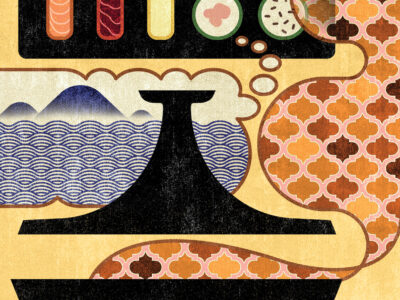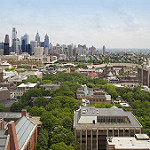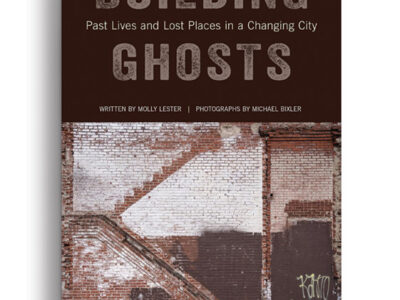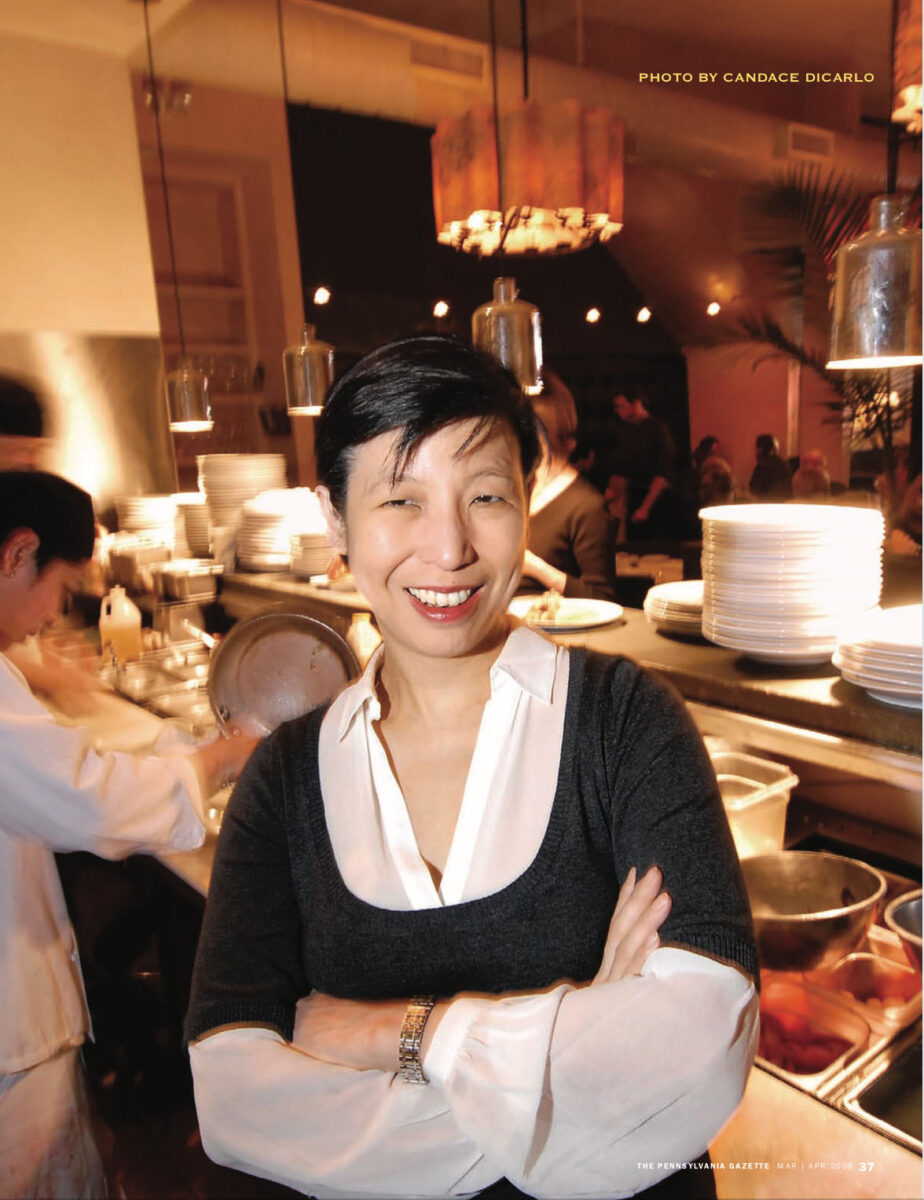
A Chinese Jersey Girl in search of American cuisine.
By Ellen Yin | Photo by Candace diCarlo
INTERVIEW | Old Tines, New City
SIDEBAR | Penn Restaurateurs Before Ellen Yin … and Since
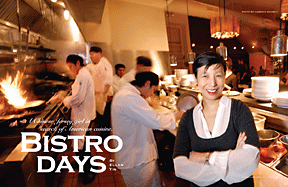

People are always curious to learn how chefs or owners enter the restaurant business.
Although a lucky few know their career calling right away, the rest of us figure it out by trial and error. Of course, we all have one thing in common: a love of good food.
During my childhood, good food was a part of my daily life, thanks to my mother, Ching Yun Yin. Although many of our relatives and friends took her good cooking for granted, my brothers and I had a sense that our nightly dinners were a cut above normal home cooking. Whereas other kids our age were eating meatloaf, pot roast, pasta, or chicken, we were treated to a smorgasbord of five or six different traditional Chinese dishes every night; seaweed, jellyfish, braised oxtails, chicken feet, roasted duck in soy sauce, prawns with their heads on, and steamed whole fish were among the usual dishes at the table. Because my mom’s family was originally from Shanghai and my father’s family was from Hunan, she exposed us to a variety of ingredients and made specialties from different regions of China.
Some of my fondest childhood memories include sitting at the kitchen table with my grandmother and my mom, rolling and wrapping dumplings. I would listen to my mom and grandmother describing how to make the perfect dumpling, elaborating on its consistency, size, filling, and cooking method. Then, when I was in high school, I started baking simple fruit breads, brownies, and cakes in my home economics class. Soon, I was experimenting with all kinds of baking recipes. I couldn’t wait until I was old enough to get a job in a restaurant kitchen so I could learn more about cooking.
The summer I turned 16, I began working at the Chinese Kitchen, a small restaurant just outside our town of Rumson, New Jersey. It was a tiny place that specialized in Mongolian barbecue. Even though Rumson was a bedroom community for New York, the Chinese Kitchen was considered exotic at the time. Raw meat would be sliced to order, marinated in a sauce customized by each guest, and cooked on a special Mongolian barbecue grill. The owners had another restaurant as well, and since the menu at the Chinese Kitchen was so limited, I wanted to work at their other location as soon as I had mastered that job. At the second restaurant, I helped make spring rolls, fried rice, and other simple foods. The kitchen was located by the entrance to the dining room, and I enjoyed catching glimpses of people enjoying their meals, or overhearing the conversations of the waiters and waitresses. Everything about that restaurant fascinated me.
I started out in the kitchen, but the more I worked, the more intrigued I became by the idea of serving people. So I applied for a job as a busser at the Fromagerie, the most upscale restaurant in the area, which was just around the corner from where we lived. It had an excellent reputation throughout New Jersey and was one of the few restaurants in the area that had been reviewed by The New York Times. In the early 1980s, people still considered French food the epitome of gourmet cuisine. I remember how I felt when I pushed open the restaurant’s heavy wooden door for the first time. The door reminded me of the entrance to a mansion, and when I entered the restaurant and looked around, I suddenly became very nervous. I had never eaten at a restaurant that had tables set with fine tablecloths, multiple pieces of silver, fancy china, and stemware. At home, we just used chopsticks and maybe a spoon.
Despite my anxiety, I applied for a job there, and I was hired as a busser. For the next two years, the Fromagerie was my hobby. I became friends with the other bussers, servers, cooks, and bartenders. And working there exposed me to foods I had never tasted before, such as fettuccine Alfredo and quiche. My mom never cooked with cream or butter, and we certainly didn’t eat cheese at home. The blue varieties struck me as particularly stinky and unappealing at first. I can’t say that I became a total convert, but at least I would try cheese on occasion. I also learned a lot about desserts, because the Fromagerie made its own pastries. At home, I tried to replicate pastry recipes from the restaurant and tested them out on my family—until my father finally said, “No more desserts, unless you help us eat what you make.”
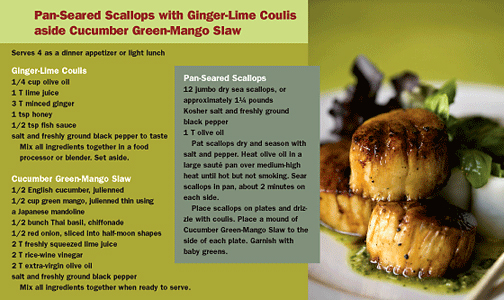
That year, when I was 18 years old, I declared my goal to open a restaurant after college. But my parents thought that I would have more financial security and an easier career if I became a doctor or an engineer. As a compromise, I entered the University of Pennsylvania’s Wharton School in Philadelphia to study economics and business. Because Penn was only an hour and a half away, I would rush home on the weekends to visit my friends at what we called the Fromage. But eventually I realized that I didn’t have to go home to be in a restaurant. I got a job at the Conversation Cafe, a dingy basement cafe in Houston Hall. Business was slow, and when the owner asked if I had any ideas, I suggested serving desserts in addition to pastries. The next thing I knew, I was making them in my dorm room in a toaster oven.
Yet even my efforts could not save the cafe from closing. Next I found a job as a server at the only French restaurant near campus, La Terrasse. Immediately life seemed exciting again. La Terrasse served simple, traditional French cuisine with an Asian twist. That summer, I stayed in Philadelphia instead of going home. In less than a year, I had formed new restaurant friends (many of whom are still my closest friends) and met many customers, some of whom now come to Fork.
In my junior year, one of my classes required students to form teams to come up with plans for a new business. A bartender at La Terrasse named Wain Ballard [W’86] and I put together a business plan for the Harmony Cafe. Interestingly enough, the proposed cafe was located in Old City at the corner of Third and Arch streets, a block away from Fork.
Although I learned a lot through this effort, the project gave me a glimpse of a harsh reality: my dreams needed capital to fuel them. Without any angel investors or my own money, I had to put my ambitions on hold and settle for looking for a “real” job after graduation.
Over the next five years, I held various jobs in advertising and fundraising, but I couldn’t stay at any one for more than a year. However excited I was at the beginning of each job, I quickly became bored. At least I was narrowing down my options! Finally I decided to return to school to try once again to figure out “what to do with my life.” Two years later, I graduated with an MBA in health care administration from Wharton and began my job search again.
At that point, I had lived in Philadelphia for almost 10 years, and the city had already begun to change for the better. It was even selected as one of the best U.S. cities in which to live. I had formed even more friendships by then and really didn’t see how any out-of-town job could entice me to give that up. Also I was learning a lot about planning and developing a business at my new job at a health care consulting firm. Yet even after I became an independent consultant, I continued to dream about opening a restaurant. I craved the creativity that had been missing in all of my other jobs. I loved food, entertaining and serving people, and I devoured any books or magazines I came across that were related to restaurants, food reviews, or cooking.
I still remember the moment when I decided to try to make my dream a reality. I was 31. While sitting in a bookstore, I picked up a copy of Food & Wine and realized that almost every featured restaurateur was between the ages of 25 and 45. If they could do it, why couldn’t I?
From “Introduction: In Search of American Cuisine” as it appears in Forklore: Recipes and Tales From an American Bistro by Ellen Yin W’87 WG’93. Copyright ©2007 by Ellen Yin. Used by permission of Temple University Press.
INTERVIEW
Old Tines, New City
Ten years after opening Fork, Ellen Yin revisits the beginning of Philadelphia’s restaurant renaissance.
Philadelphia’s recorded culinary history stretches back past the Declaration of Independence, when John Adams supped with other delegates at the “most genteel” City Tavern, but the last decade has seen more than its fair share of change. Ten years ago, the Old City neighborhood offered few reasons to linger long past dusk, much less the dinner hour. But these days you could eat at a different restaurant every night for three months without venturing beyond a four-block radius.
One of the progenitors of this most recent “restaurant renaissance” was Fork, opened in 1997 by Ellen Yin W’87 WG’93. When Yin first fixed her hopes on a fire-damaged cavity near the corner of Market and Third streets, even her partners had trouble seeing how an upscale bistro could succeed next-door to a dollar store. But that didn’t stop her. Building her business around the Slow Food credo long before it became fashionable, she helped to show that the neighborhood was hungry for innovation. And just plain hungry, period.
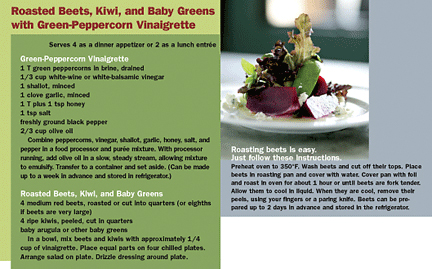
To celebrate the restaurant’s 10th anniversary, Yin has written Forklore: Recipes and Tales from an American Bistro. Equal parts restaurant memoir and recipe collection, the book offers a peek behind the scenes of Fork’s journey from upstart to institution. An excerpt starts on page 38. Yin also spoke with the Gazette about her mother’s home cooking, the thrill of eating out, and the search for American cuisine. Here is an edited version of that conversation.
One thing that really comes through in your book is how much you love restaurants. You say that in the last 10 years, you’ve eaten out almost 3,650 days. Can that really be true?
Well, I mean, at work!
But what first turned you on to food was your mother’s home cooking. Tell me about that.
I’m Chinese, and growing up in an Asian household we were exposed to a lot of exotic foods. And we didn’t really have much choice in what we were going to eat. If my mom put it on the table, we were expected to eat it. Chicken feet, tendon, whole fish, shrimp with heads on, tripe—all these things that are maybe considered exotic by the American cuisine of the time, in the ’70s and ’80s. But my father was really an adventurous eater. My mom didn’t really like to eat things that were outside of her vocabulary, but my dad always wanted to try new things. He was the one who loved blue cheese, hard cheeses—and, I just found out from my mom the other day, oysters on the half-shell. All these things that she still wouldn’t really conceive of eating.
So the lunches you packed for school must have looked pretty different than what your classmates brought.
I didn’t want to eat pizza or grilled cheese or anything like that. So a lot of times my mom would pack lunch for us. But we also wanted to assimilate. It was a time when there weren’t as many people in the area from different countries. Now everybody wants to have their child learn different languages. Then, we were all trying to assimilate and be as American as possible. So we wanted McDonald’s, we wanted TV Dinners, we wanted all those types of things. So my mom would sometimes pack us peanut-butter-and-jelly sandwiches like all the other kids.
Assimilation is probably the wrong word, and fusionis such a cliché, but there are all sorts of different influences that inform the cooking at Fork. Do you see a continuity between the way you thought about food as a child and what you’re doing now?
Well, my view of food was a lot more limited. I mean, I probably never really had true Mexican cuisine. Maybe Tex-Mex, but not Nueva Latina cuisine. I worked at a French restaurant, so I was exposed to a lot of classic French cuisine … I think that my mom’s and dad’s introduction to all different kinds of flavors made me more open-minded.
It seems like by the time you were a teenager, you just couldn’t get enough of restaurants. No matter whether you were wrapping spring rolls in the kitchen, bussing tables, taking orders—
I loved it. It was, one, a way to have a little freedom, as a teenager. And earning your own money gives you some sense of independence. But I loved the restaurant because there were so many different types of people—creative types, people who didn’t have the same goals as I did … you know—people who were artists, people who were traveling, people who had exposure to things that I felt were more worldly than what I had been exposed to.
And by the time you started your own restaurant, you’d been through Wharton as both an undergrad and an MBA student. I guess that nowhere along the line did someone tell you that the restaurant business is the quickest way to bankruptcy court.
As an undergrad I had put together a business plan for one of my classes. And I was definitely aware of what everybody says about the restaurant industry, but I’d felt for so long that it was something I wanted to do. When I was in high school, when I was in college, all through my young adulthood, I had this feeling that I wanted to open a restaurant. By the time I did, when I was 32 years old, I had worked in the health-care industry, but I still didn’t feel the kind of satisfaction that I felt when I’d worked in restaurants—whether it was in the kitchen or on the dining room floor. And the creative process of developing the restaurant was even more exciting than I had anticipated. I really think of a restaurant as a multi-sensory experience. There’s the visual component, there’s the eating component, there’s the music—there’s so many different components of creating an experience for people. I think that’s like an art in itself.
Was your vision for Fork fully formed in your mind from the beginning, or did it grow in unexpected ways over time?
When you have something on paper, you don’t know how it’s going to evolve. When I worked at La Terrasse in college, I loved La Terrasse. In my mind I always thought I wanted to have something similar to that, in terms of French-Asian cuisine. But when I had to find a chef, the person that I had the best connection with didn’t cook that style of food. So things evolved. I didn’t know who my opening staff would be. I don’t think I ever envisioned it would be as elegant as it is. I didn’t think it would be a destination restaurant. So all these things are constantly changing—as are all the elements around you. When we first opened the restaurant, there was nobody in Old City. Now there are a lot of restaurants in Old City. The dining scene in Philadelphia has become much more sophisticated.
Do you feel like you’ve played a role in the larger food culture of Philadelphia, which has changed so dramatically?
I don’t know if I’d take that much credit. But I will say that there are restaurants that have offshoots. One of my sous chefs opened up a restaurant. We have people who we’ve trained who have gone on to become sous chefs, or chefs de cuisine, or dining room managers. So from that perspective, sure, we’ve influenced the dining scene in Philadelphia.
The last decade, and especially the last few years, seems like a period of empire building for celebrity chefs and restaurateurs. Whether you’re looking at a TV star like Mario Batali, or somebody like Thomas Keller [of the French Laundry], or [Philadelphia restaurant mogul] Stephen Starr, the dominant trend is toward brand building and franchise expansion. But despite your success and longevity, you haven’t exactly followed that path. How come?
We did expand to Fork:etc, and there is the possibility of additional Fork:etc’s in the city, but I really enjoy being part of the hospitality process. I’m involved on a day-to-day basis with customer service, and creation of the menu, and I think that if I were to franchise or expand to other restaurants, part of that would be diluted.
Have customers changed over the last 10 years? Nowadays people seem to think about food in ethical terms more often than they used to. How much of that filters down to the restaurant?
People are much more concerned about what they’re eating. But people who come to Fork generally know what our philosophy is, and they appreciate that, and they’re willing to pay a slight premium to have what they want.
One of your chapters is titled “In Search of American Cuisine.” The term American cuisine gets thrown around a lot, and it’s not always clear what people mean by it. What does it mean to you, today?
Before, I think people perceived American cuisine to be comfort food. In fact, when we opened, people would say, “Oh, Fork—comfort food!” And I was just like, “I don’t see that.” Even at the beginning, we always defined ourselves as New American—meaning eclectic, international influences from all over the world. As someone who’s looking always to have what’s new and what’s interesting, that’s what my 10-year ride has been like. Trying to find what people would be interested in eating. Trying to find some new idea of how to be innovative. But still be simple. You know, I’ve had the opportunity to eat so much food outside of my home, and travel, and experience great food—but one of the most comforting foods to me is a hamburger. I always want a hamburger with great French fries. And it’s not like you can just find it anywhere.
SIDEBAR
Penn Restaurateurs
Before Ellen Yin …
It takes mettle to abandon a traditional career path for the risky life of a restaurateur, but Ellen Yin isn’t the only Penn grad who’s tried to breathe life into Philadelphia’s culinary scene. Twenty years before she took a chance on Old City by opening Fork there, an older pair of alums rolled the dice at an even more uncertain moment in the city’s history.
Roger Harman Gr’77 and the late Duane Ball Gr’73 were both teaching college economics when they got bitten by the restaurant bug in 1979. “We became kind of disillusioned with the academic life,” Harman recently recalled. While inflation and unemployment hovered at double-digit levels—a scenario that textbooks of the time maintained was impossible—the two friends soured on the tenure chase.
“We felt that it would be more interesting to become part of the economy rather than to talk about the economy,” Harman says. Discovering an abandoned laundry for sale at 47th Street and Chester Avenue in West Philly, they pounced. “We had enough money on a credit card to get the building. It was like $7,000.”
After sprucing it up and christening it the Gold Standard, they opened their doors to the eating public in 1979. A few years later, Philadelphia magazine bestowed one of its annual Best of Philly awards on the place—cheekily naming it the “Best Restaurant in an Unlikely Location.”
By that time, the offbeat location had attracted a regular who would go on to play a key part in the restaurateurs’ future: Penn President Sheldon Hackney Hon’93. “He liked going there I think in part because people didn’t really recognize him or bother him,” Harman says. “And Sheldon, or one of his aides, came to us one day and said, ‘You know, the Christian Association is looking for a new tenant.’”
The Christian Association occupied the building now known as The Arch on Locust Walk. In 1983, Ball and Harman shifted their operation there, opening the Palladium, which served the Penn community for the next 20 years.
“It was ironic. Here we were trying to get away from academia, and we landed smack in the middle of it,” Harman laughs. “All these professors would come in and want to discuss recent things they’d read in economics. I didn’t read that stuff anymore. I read home economics!”
In 2003, as the administration of President Judith Rodin CW’66 Hon’04 felt pressure to remove alcohol from campus, the Palladium shut its doors. “As near as I can tell, ours was the last restaurant and bar in the middle of an Ivy League campus,” Harman says. “I don’t think there are any left.”
These days Harman spends his days a little closer to the old Gold Standard location, where his third restaurant, Abbraccio, has been serving Italian food since 2003. Perched between University City and southwest Philadelphia, Harman reckons he attracts “the most diverse clientele of just about any restaurant” in town.
“We have people with very modest means, and then people who want the latest specials,” he says. “It’s been a struggle. We’re still not out of the woods by any means. But it’s been a lot of fun. It’s a neighborhood restaurant.”
… And Since
Restaurant chefs come from every background imaginable, but it would be hard to find one who sacrificed a more lucrative job than the one Steven Cook W’95 abandoned in order to pursue a life in the kitchen. For six years after graduating from Wharton, Cook worked for the global private-equity giant Blackstone, which later made its founder a billionaire several times over when the firm went public in 2007.
“People look at me like I’m crazy for leaving,” Cook says. “And sometimes I agree with them.”
Nevertheless, night classes at the French Culinary Institute in New York beckoned him away from the balance sheets just long enough to get him hooked on food. Soon thereafter, he realized he needed a change of scenery as well. “I realized I wasn’t going to be able to support myself on a cook’s salary, in the life that I’d grown accustomed to as a banker. And I really loved Philly.”
So he returned to his old stomping ground, where fine dining was undergoing a sort of revolution. Small restaurants without liquor licenses were starting to change the gastronomic landscape, and Cook plunged right in. First he spent a couple years polishing his kitchen skills under the chefs of two well-regarded restaurants near Rittenhouse Square. Then he came back to the University’s side of the Schuylkill to open Marigold Kitchen in October of 2004.
He couldn’t have picked a better moment. The bring-your-own-booze scene was now really beginning to blossom, and Marigold went from a cozy neighborhood eatery to an inspired destination restaurant virtually overnight. Philadelphiamagazine called it the Best New BYOB of 2005. Food & Wineplugged Cook’s “gutsy, refined dishes,” and Gourmet jumped on the bandwagon with praise in two separate issues.
Cook wasn’t content to rest on those laurels. “There are some limitations to what you can do in a 40-seat BYOB restaurant at the corner of 45th and Larchwood,” he laughs. Besides, he had discovered that he had another skill: talent scouting.
After tapping a rising chef named Michael Solomonov to take his place at Marigold’s burners, Cook set about opening Xochitl, a haute Mexican restaurant in Old City. To run the kitchen, he found a chef named Dionicio Jimenez, who’d landed in Philadelphia from Mexico nine years before and started out as a near-broke dishwasher. Evidently the Blackstone alum knew an undervalued asset when he saw one. Within months of Xochitl’s 2007 opening, Gourmet and Food & Wine were back in Philadelphia to sing Jimenez’s praises.
At the moment Cook is hard at work on his next venture, an upscale Israeli and Middle Eastern restaurant called Zahav, which he hopes to open by the middle of this year. The banker became a chef, and the chef is maturing into a full-fledged entrepreneur. “I like projects,” he explains. “It’s fun to be in a restaurant every day, and try to improve it and get it to run better. But what really gets me excited to jump out of bed in the morning is to build things.”
—T.P.


